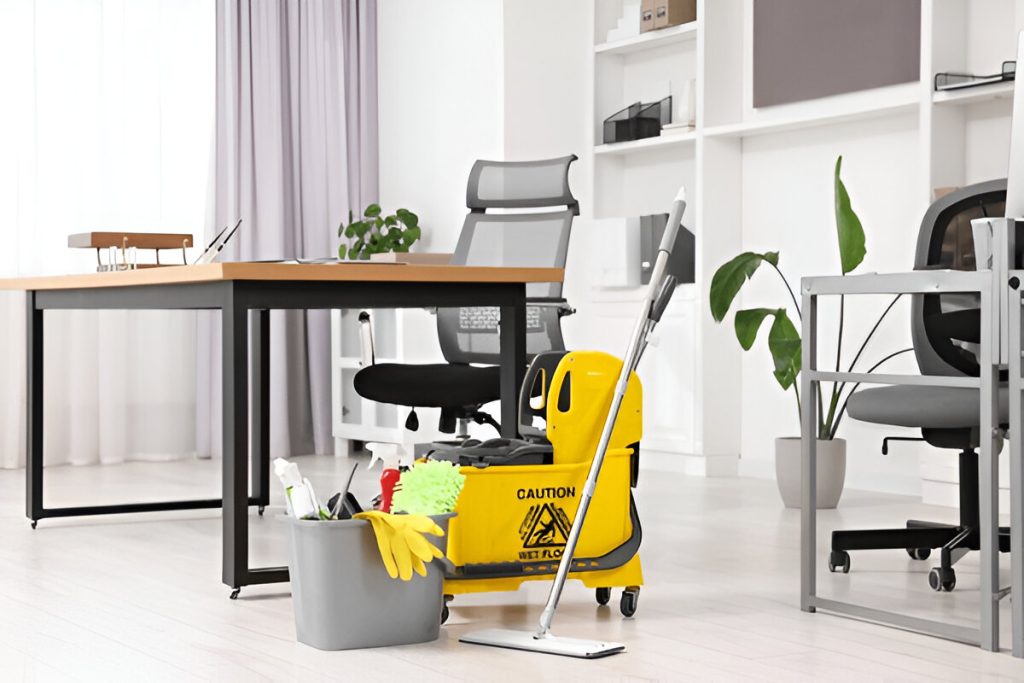Open‑plan offices invite fresh ideas and expose everyone to more dust, dander, and chemicals. Because many products hide irritants, even a spotless desk can spark sneezes. Nearly one in three employees reports allergy symptoms on the job. Consequently, facility managers must ask: Are our cleaning supplies safe for sensitive staff? After all, health-conscious workplaces boost morale and cut sick days.
Hidden Triggers Inside Common Sprays
Bright labels promise “lemon fresh” shine. However, that citrus scent may come from synthetic fragrances packed with volatile organic compounds (VOCs). Moreover, preservatives such as formaldehyde releasers extend shelf life yet irritate skin and lungs. Even so-called “antibacterial” wipes often rely on quaternary ammonium compounds, which can trigger asthma.
Typical Offenders
- Fragrances – cause headaches and watery eyes
- Bleach – releases chlorine that irritates the airways
- Ammonia – produces strong fumes, especially on glass
- Dyes – add color but no cleaning power
- Aerosol propellants – scatter particles deep into the lungs
Ingredients matter as much as frequency. Therefore, safe office janitorial services start by auditing every bottle used on-site.
Why Allergy‑Safe Supplies Matter
First, employees breathe easier, so focus improves. Second, visitors with asthma feel welcome instead of wary. Third, reducing harsh chemicals protects cleaning crews who handle solutions daily. Finally, green ratings on annual sustainability reports impress partners and clients. Because benefits multiply, switching products is a smart investment, not a trend.
Decoding Product Labels Quickly
Manufacturers use long chemical names that intimidate readers. Yet you can still spot red flags in seconds.
- Seek third-party seals. Look for Green Seal, EcoLogo, or Safer Choice.
- Scan for “fragrance‑free.” Unscented is not enough; true fragrance-free avoids masking odors.
- Check pH levels. Near-neutral cleaners (pH 6–8) cause fewer reactions than highly acidic or alkaline agents.
- Avoid chlorine. Hydrogen peroxide delivers disinfection without bleach fumes.
Because clear labeling builds trust, responsible vendors supply full data sheets on request.
Natural Isn’t Always Safer
Citrus oils, pine extracts, and vinegar solutions appear gentle. However, some botanical ingredients trigger rashes or respiratory issues. Therefore, testing small areas and gathering employee feedback remain crucial steps. Moreover, certified low-allergen formulas undergo rigorous screening, giving extra assurance beyond “all-natural” claims.
Cleaning Methods Make A Difference
Even the safest liquid fails if applied poorly. Thus, modern office janitorial services pair hypoallergenic products with smart tools.
- Microfiber cloths trap dust without lint.
- HEPA vacuums capture 99.97 % of particles, including pollen.
- Color-coded wipes prevent cross-contamination between restrooms and desktops.
- Dilution systems mix concentrates accurately, reducing residue.
- No-touch dispensers limit chemical contact for custodians.
Consequently, technique plus product equals true allergen control.
Day‑Porter Support Keeps Air Clear
Nightly crews handle deep cleaning. However, allergens accumulate during business hours. Therefore, many firms add day porters who discreetly wipe handles, empty small bins, and monitor restrooms. Quick touch-ups prevent buildup, and staff breathe easier all afternoon. Flexible office janitorial services tailor porter schedules around peak traffic, meetings, and lunch breaks.
Cost Versus Health Returns
Some managers hesitate at the slightly higher price of certified supplies. Yet consider hidden costs:
- Lost productivity from allergy flare-ups
- Higher HVAC maintenance due to dust circulation
- Negative impressions on potential clients who are sensitive to odors
- Workers’ compensation claims for chemical exposure
Safe products pay back quickly through healthier, happier teams.
Crafting an Allergy‑Smart Cleaning Plan
Step 1: Survey Staff
Send a brief questionnaire asking about sensitivities and preferred scents.
Step 2: Audit Current Inventory
List every cleaner, polish, and disinfectant in use—Mark hazard ratings.
Step 3: Replace High-Risk Items
Swap bleach sprays and fragrant air fresheners for peroxide‑- or fragrance-free versions.
Step 4: Train Custodians
Teach dilution, dwell times, and proper ventilation procedures.
Step 5: Monitor And Adjust
Track allergy complaints and product feedback monthly. Modify routines accordingly.
Because continuous improvement prevents regression, documentation is vital.
Partnering with Specialists
Managing all details alone can overwhelm internal teams. Consequently, many companies hire providers who focus on health-first methods. When evaluating proposals, ask these questions:
- Which hypoallergenic products do you supply?
- Do crews hold certifications in chemical safety?
- Is usage data available for review?
- Can schedules adapt during pollen season?
- How often are vacuums serviced and filters replaced?
Only vendors who answer confidently will maintain consistent quality.
Regulations and Future Standards
Governments increasingly restrict VOCs in commercial products. Meanwhile, green‑building certifications reward low-toxicity cleaning. Therefore, proactive upgrades shield companies from surprise compliance costs. Furthermore, savvy clients favor vendors who prioritize wellness. By adopting safe supplies now, organizations stay ahead of shifting regulations and customer expectations.
Role of HVAC In Allergen Control
Safe cleaners matter, yet air circulation completes the puzzle. Thus, coordinate janitorial schedules with ventilation cycles. Running fans after mopping speeds drying and reduces humidity that breeds mold. Likewise, replacing filters quarterly captures drifting particles. Because systems work together, collaboration between custodians and maintenance teams is essential.
Recycling and Waste Management
Allergy-friendly programs extend beyond bottles. For instance, lined recycling bins prevent dust aerosolization when paper is collected. Additionally, sealed lids on waste carts block odor-causing bacteria. Consequently, cleaner disposal methods support overall air purity.
Employee Tips for Daily Defense
Even with stellar office janitorial services, staff can help keep irritants low:
- Store scented lotions at home.
- Keep desktop plants trimmed and pest-free.
- Report spills immediately before they dry and flake.
- Wipe keyboards weekly with provided alcohol‑free cloths.
- Avoid aerosol air fresheners; choose desk fans for cooling instead.
Shared responsibility strengthens outcomes and builds culture.
Conclusion: Clean and Comfortable Workdays
Ultimately, allergy-safe cleaning is not a fad. It is a crucial pillar of workplace wellness that protects health, productivity, and reputation. Organizations safeguard people and facilities by selecting low-toxicity products, adopting advanced tools, and partnering with health-focused experts—reliable Janitorial designs tailored plans that swap harsh chemicals for smart solutions—without sacrificing shine.
Ready to breathe easier? Contact Reliable Janitorial today, and let’s create an allergy-safe schedule that lets your team thrive from nine to five.



